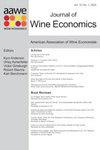1962-2019年全球葡萄酒贸易双边模式的解释
IF 1.6
4区 经济学
Q2 AGRICULTURAL ECONOMICS & POLICY
引用次数: 0
摘要
摘要本研究使用重力模型来解释1962年以来全球葡萄酒贸易的双边模式。据我们所知,这是对全球葡萄酒贸易的首次研究,涵盖了第二波全球化。结果表明,距离、共同语言和1945年后的共同殖民者对葡萄酒贸易的影响在1991-2019年期间低于1962-1990年期间。我们还使用重力模型来解释各国葡萄园葡萄品种组合的相似性对双边葡萄酒贸易模式的影响。尽管我们的模型不允许我们确定因果关系,但结果表明,各国之间的葡萄酒贸易量越大,葡萄酒葡萄品种的组合就越紧密。本文章由计算机程序翻译,如有差异,请以英文原文为准。
Explaining bilateral patterns of global wine trade, 1962–2019
Abstract This study uses gravity models to explain bilateral patterns of global wine trade since 1962. This is, to our knowledge, the first study on global wine trade covering the second wave of globalization as a whole. The results suggest that the impact of distance, common language, and common colonizer post-1945 on wine trade was lower in the 1991–2019 period than in the 1962–1990 period. We also use gravity models to explain the impact on bilateral wine trade patterns of similarities across countries in the mix of winegrape varieties in their vineyards. Although our models do not allow us to identify causality, the results suggest that countries trade more wine with each other the closer their mix of winegrape varieties.
求助全文
通过发布文献求助,成功后即可免费获取论文全文。
去求助
来源期刊

Journal of Wine Economics
Agricultural and Biological Sciences-Food Science
CiteScore
3.20
自引率
28.60%
发文量
33
期刊介绍:
The Journal of Wine Economics (JWE), launched in 2006, provides a focused outlet for high-quality, peer-reviewed research on economic topics related to wine. Although wine economics papers have been, and will continue to be, published in leading general and agricultural economics journals, the number of high-quality papers has grown to such an extent that a specialized journal can provide a useful platform for the exchange of ideas and results.
The JWE is open to any area related to the economic aspects of wine, viticulture, and oenology. It covers a wide array of topics, including, but not limited to: production, winery activities, marketing, consumption, as well as macroeconomic and legal topics. The JWE has been published twice a year and contains main papers, short papers, notes and comments, reviews of books, films and wine events, as well as conference announcements. From 2013 on, the JWE has been published three times per year.
The Journal of Wine Economics is fully owned by the American Association of Wine Economists (AAWE) and, since 2012, has been published by Cambridge University Press.
 求助内容:
求助内容: 应助结果提醒方式:
应助结果提醒方式:


